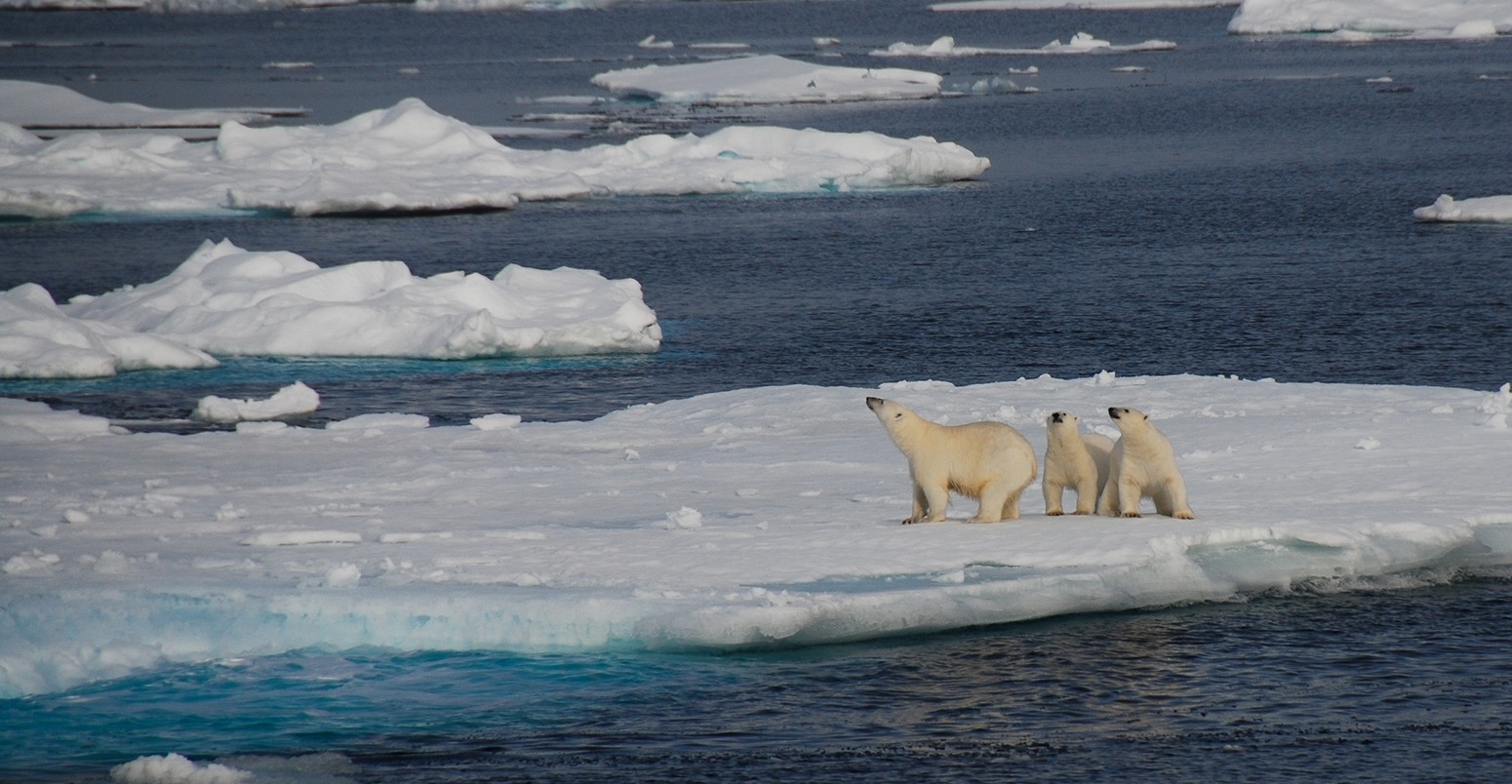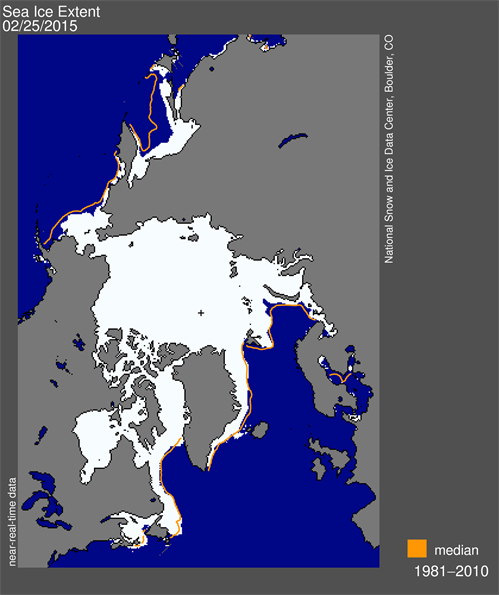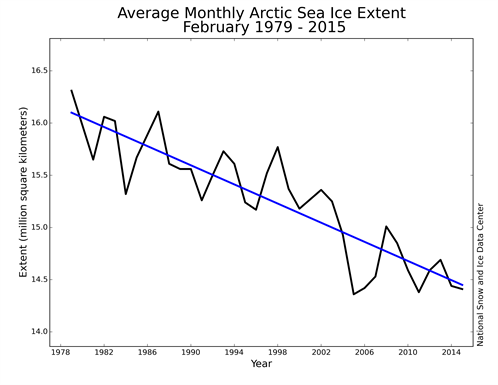
Arctic sea ice hits lowest winter peak on record
Carbon Brief Staff
03.20.15The latest satellite data shows the winter maximum extent of Arctic sea ice this year is the lowest recorded since measurements began in 1979. Provisional data from the National Snow and Ice Data Center (NSIDC) in the US shows 2015 has broken the previous record set in 2011 by 130,000 square kilometers.
Warm air temperatures in the Arctic have been a key reason why less ice has formed this winter, the NSIDC says.
Winter freeze
It’s around this time of year when the freeze-up of Arctic sea ice through the winter hits a peak, and signals the start of the melt season in spring and summer.
Using satellites, scientists can mark this point every year, recording when the Arctic sea ice hit its largest extent and the size it reached.
For 2015, the NSIDC thinks this point was on 25 February, when sea ice covered 14.54 million sq km. At 1.1 million sq km smaller than the 1981-2010 average, this year has set a new record for the lowest winter peak, which you can see in the graph below.

Arctic sea ice extent as of March 18, 2015, along with daily ice extent data for four previous years. The 1981 to 2010 average is the dark grey line. The grey shaded area around the average line shows the two standard deviation range of the data. Source: NSIDC
The scientists measure each day’s extent as an average over the previous five days. They then wait for a downturn in ice in order to see when the peak occurred. As the sea ice extent can vary from day-to-day, the NSIDC says that there could be a late surge of ice growth in the coming weeks, but it “now appears unlikely that there could be sufficient growth to surpass the extent reached on 25 February”.
The NSIDC will publish its final analysis of 2015 winter sea ice in early April.
Early maximum
In addition to being a record low, the winter maximum was also much earlier than usual, the NSIDC says. The average date for the winter peak over 1981-2010 is the 12 March, so this year’s is around two weeks early, and just a day later than the earliest on 24 February in 1996.

Arctic sea ice extent for 25 February 2015. The orange line shows the 1981 to 2010 median extent for that day. The black cross indicates the geographic North Pole. Source: NSIDC
Less sea ice has formed this winter because of warm air conditions in several areas of the Arctic, the NSIDC says. There was low ice extent in the Bering sea, for example, where temperatures were as much as four to six degrees Celsius above average during February. Conditions in the Barents Sea near Svalbard were also unusually warm in March, with air temperatures between eight and 10 degrees above average.
This new record is not unexpected, Prof Jonathan Bamber, review editor of the cryosphere chapter of the latest Intergovernmental Panel on Climate Change report, tells Carbon Brief:
“This is consistent with what we know is happening in the Arctic. It’s experiencing warming that’s twice as fast as the rest of the planet.”
And as the graph below shows, this year is not a one-off, he says:
“Arctic sea ice has been declining ever since the microwave satellite record began in 1979. While a record in one year on it’s own is not conclusive, it is a continuation of the long-term trends we’ve been seeing.”

Monthly February ice extent for 1979 to 2015 shows a decline of 2.9% per decade relative to the 1981 to 2010 average. Source: NSIDC
Prof Andrew Shepherd, Principal Scientific Advisor to the European Space Agency CryoSat satellite mission, tells Carbon Brief that measuring sea ice extent is a good gauge of what’s happening in the Arctic:
“We know that changes in the extent of Arctic sea ice are a sensitive indicator of its amount, and so this low maximum is another cause for concern.”
But for a complete picture, we need to know how thick the ice is too, Shephard says:
“For the time being we usually have to wait a month or so for those measurements to be ready. Because we know people want faster answers, the Cryosat team have been working hard to speed things up, and we hope to be able to provide near real time measurements of sea ice thickness any day now.”
What did the media say?
The Guardian, which recently launched a climate change campaign, highlights the impact that the diminishing sea ice is having on the people and animals that live inside the Arctic circle. The 2,600 people who live in Svalbard, a Norwegian archipelago, are having a hard time due to too much ice on land and not enough in the sea, says Kim Holmén, the international director of the Norwegian Polar Institute, adding that the reindeer are also struggling to find food.
The Times says that an unusually warm winter in Alaska and Russia contributed to the record low. It includes a suggestion by Alexander Shestakov, WWF’s Arctic spokesman, that Arctic states should create a network of “resilient marine areas” around the pole.
Reuters quotes Sebastian Gerland, also from the Norwegian Polar Institute, who points out that only the ice that is the thickest and most resilient is now surviving for more than one winter. The article also highlights that, while Arctic thaw is making the region more accessible, low oil prices are discouraging companies from exploring for more reserves in the complicated frozen environment, while tension between Russia and the West has limited interest in Arctic shipping.
The Washington Post points out that, although the extent of the winter maximum receives less attention than the summer minimum, it is important to take the two trends as a whole. Together, it says, they underscore “the dramatic overall change in the Arctic system.” The US is about to take up the chairmanship of the Arctic council, it adds.
The BBC‘s science editor David Shukman highlights some of the caveats, including that natural variability causes huge variations in Arctic sea ice extent year-on-year. But he also highlights that the “clear pattern of decline” is a subject of intense research, due to its impact on shipping lanes, oil and gas accessibility and potential path of the jet stream.
Many of the papers point out that the overall decline in Arctic sea ice shows the noticeable impact that climate change is already having on the world – despite some recent commentary from climate sceptics following the announcement that Antarctic sea ice reached its highest January levels ever this year.
Some papers also include the caveat that a low winter maximum will not automatically lead to a low summer minimum, and that a surge later in the season is still possible.
Update: Friday 20th March 21:00: Quotes from Prof Shepherd were added.
Main image: Family of polar bears on an ice, Greenland.
Update: Monday 23rd March 10:45: Penultimate paragraph corrected to say that January Antarctic sea ice levels were a record, rather than February. Link to announcement also added.

